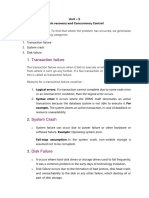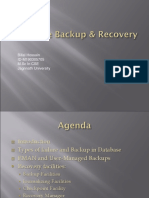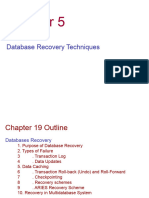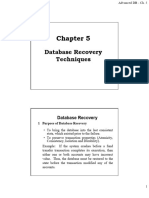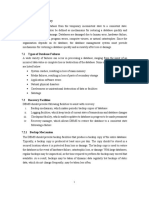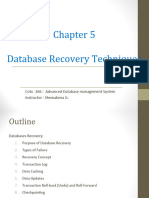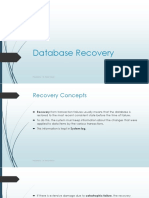Advanced Database MS 5
Advanced Database MS 5
Uploaded by
3d nat natiCopyright:
Available Formats
Advanced Database MS 5
Advanced Database MS 5
Uploaded by
3d nat natiOriginal Title
Copyright
Available Formats
Share this document
Did you find this document useful?
Is this content inappropriate?
Copyright:
Available Formats
Advanced Database MS 5
Advanced Database MS 5
Uploaded by
3d nat natiCopyright:
Available Formats
Advanced Database system
CHAPTER 5
DATABASE RECOVERY TECHNIQUES
Recovery Outline and Categorization of Recovery Algorithms
Recovery from transaction failures usually means that the database is restored to the
most recent consistent state just before the time of failure.
To do this, the system must keep information about the changes that were applied to
data items by the various transactions. This information is typically kept in the system
log.
A typical strategy for recovery may be summarized informally as follows:
1. If there is extensive damage to a wide portion of the database due to
catastrophic failure, such as a disk crash, the recovery method restores a past
copy of the database that was backed up to archival storage and reconstructs a more
current state by reapplying or redoing the operations of committed transactions
from the backed up log, up to the time of failure.
2. When the database on disk is not physically damaged, and a non-catastrophic
failure has occurred, the recovery strategy is to identify any changes that may cause
an inconsistency in the database.
For non-catastrophic failure, the recovery protocol does not need a
complete archival copy of the database. Rather, the entries kept in the
online system log on disk are analyzed to determine the appropriate actions
for recovery.
Conceptually, we can distinguish two main techniques for recovery from non-
catastrophic transaction failures:
1. Deferred update and
2. Immediate update.
Deferred Update
The deferred update techniques do not physically update the database on disk until after a
transaction reaches its commit point; then the updates are recorded in the database.
Before reaching commit, all transaction updates are recorded in the local transaction
workspace or in the main memory buffers that the DBMS maintains.
Before commit, the updates are recorded persistently in the log, and then after commit,
the updates are written to the database on disk.
If a transaction fails before reaching its commit point, it will not have changed the database in
any way, so UNDO is not needed.
It may be necessary to REDO the effect of the operations of a committed transaction from the
log, because their effect may not yet have been recorded in the database on disk. Hence, deferred
update is also known as the NO-UNDO/REDO algorithm.
AUWC School of Technology and Informatics Page 1
Advanced Database system
Immediate Update
In the immediate update techniques, the database may be updated by some operations
of a transaction before the transaction reaches its commit point.
However, these operations must also be recorded in the log on disk by force-writing
before they are applied to the database on disk, making recovery still possible.
If a transaction fails after recording some changes in the database on disk but before reaching
its commit point, the effect of its operations on the database must be undone; that is, the
transaction must be rolled back.
In the general case of immediate update, both undo and redo may be required during
recovery. This technique, known as the UNDO/REDO algorithm, requires both operations
during recovery, and is used most often in practice.
A variation of the algorithm where all updates are required to be recorded in the database on
disk before a transaction commits requires undo only, so it is known as the UNDO/NO-REDO
algorithm.
Caching (Buffering) of Disk Blocks
Typically, multiple disk pages that include the data items to be updated are cached into
main memory buffers and then updated in memory before being written back to disk.
The caching of disk pages is traditionally an operating system function, but
because of its importance to the efficiency of recovery procedures, it is handled by
the DBMS by calling low-level operating systems routines.
When the DBMS requests action on some item,
1. First it checks the cache directory to determine whether the disk page containing the
item is in the DBMS cache.
2. Second if it is not, the item must be located on disk, and the appropriate disk pages are
copied into the cache.
It may be necessary to replace (or flush) some of the cache buffers to make space available for
the new item.
Some page replacement strategy similar to these used in operating systems, such as least recently
used (LRU) or first-in-first out (FIFO), or a new strategy that is DBMS-specific can be used to
select the buffers for replacement, such as DBMIN or Least-Likely-to-Use.
Two main strategies can be employed when flushing a modified buffer back to disk.
1. In-place updating, writes the buffer to the same original disk location, thus
overwriting the old value of any changed data items on disk.
2. Shadowing, writes an updated buffer at a different disk location, so multiple
versions of data items can be maintained.
In general, the old value of the data item before updating is called the before image
(BFIM), and the new value after updating is called the after image (AFIM).
AUWC School of Technology and Informatics Page 2
Advanced Database system
If shadowing is used, both the BFIM and the AFIM can be kept on disk; hence, it is not
strictly necessary to maintain a log for recovering.
Write-Ahead Logging, Steal/No-Steal, and Force/No-Force
When in-place updating is used, it is necessary to use a log for recovery.
In this case, the recovery mechanism must ensure that the BFIM of the data item is
recorded in the appropriate log entry and that the log entry is flushed to disk before the
BFIM is overwritten with the AFIM in the database on disk. This process is generally
known as write-ahead logging.
There are two types of log entry information included for a write command:
1. The information needed for UNDO: The UNDO-type log entries include the old value
(BFIM) of the item since this is needed to undo the effect of the operation from the log (by
setting the item value in the database back to its BFIM).
2. The information needed for REDO. A REDO-type log entry includes the new value
(AFIM) of the item written by the operation since this is needed to redo the effect of the
operation from the log (by setting the item value in the database on disk to its AFIM).
Standard DBMS recovery terminology includes the terms steal/no-steal and force/no-
force, which specify the rules that govern when a page from the database can be
written to disk from the cache:
1. If a cache buffer page updated by a transaction cannot be written to disk before the
transaction commits, the recovery method is called a no-steal approach.
On the other hand, if the recovery protocol allows writing an updated
buffer before the transaction commits, it is called steal approach.
2. If all pages updated by a transaction are immediately written to disk before the
transaction commits, it is called a force approach. Otherwise, it is called no-force.
The force rule means that REDO will never be needed during recovery,
since any committed transaction will have all its updates on disk before
it is committed.
The deferred update (NO-UNDO) recovery scheme follows a no-steal approach. However,
typical database systems employ a steal/no-force strategy.
The advantage of steal is that it avoids the need for a very large buffer space to store all
updated pages in memory.
The advantage of no-force is that an updated page of a committed transaction may still
be in the buffer when another transaction needs to update it, thus eliminating the I/O
cost to write that page multiple times to disk, and possibly to have to read it again from
disk.
This may provide a substantial saving in the number of disk I/O
operations when a specific page is updated heavily by multiple
transactions.
AUWC School of Technology and Informatics Page 3
Advanced Database system
Transaction Actions That Do Not Affect the Database
In general, a transaction will have actions that do not affect the database, such as
generating and printing messages or reports from information retrieved from the
database.
If a transaction fails before completion, we may not want the user to get these reports,
since the transaction has failed to complete.
If such erroneous reports are produced, part of the recovery process would have
to inform the user that these reports are wrong, since the user may take an
action based on these reports that affects the database. Hence, such reports
should be generated only after the transaction reaches its commit point.
A common method of dealing with such actions is to issue the commands that generate the
reports but keep them as batch jobs, which are executed only after the transaction
reaches its commit point. If the transaction fails, the batch jobs are canceled.
NO-UNDO/REDO Recovery Based on Deferred Update
The idea behind deferred update is to defer or postpone any actual updates to the
database on disk until the transaction completes its execution successfully and reaches
its commit point.
During transaction execution, the updates are recorded only in the log and in the cache
buffers.
We can state a typical deferred update protocol as follows:
1. A transaction cannot change the database on disk until it reaches its commit point.
2. A transaction does not reach its commit point until all its REDO-type log entries
are recorded in the log and the log buffer is force-written to disk.
Notice that step 2 of this protocol is a restatement of the write-ahead logging (WAL)
protocol.
Because the database is never updated on disk until after the transaction commits,
there is never a need to UNDO any operations.
REDO is needed in case the system fails after a transaction commits but before all
its changes are recorded in the database on disk.
In this case, the transaction operations are redone from the log entries
during recovery.
For multiuser systems with concurrency control, the concurrency control and recovery
processes are interrelated.
Consider a system in which concurrency control uses strict two-phase locking, so the
locks on items remain in effect until the transaction reaches its commit point. After that,
the locks can be released. This ensures strict and serializable schedules.
If a transaction is aborted for any reason (say, by the deadlock detection method), it is
simply resubmitted, since it has not changed the database on disk.
A drawback of the method described here is that it limits the concurrent
execution of transactions because all write-locked items remain locked until the
transaction reaches its commit point.
AUWC School of Technology and Informatics Page 4
Advanced Database system
Additionally, it may require excessive buffer space to hold all updated items until the
transactions commit.
The method’s main benefit is that transaction operations never need to be undone, for two
reasons:
1. A transaction does not record any changes in the database on disk until after it reaches
its commit point—that is, until it completes its execution successfully. Hence, a
transaction is never rolled back because of failure during transaction execution.
2. A transaction will never read the value of an item that is written by an uncommitted
transaction, because items remain locked until a transaction reaches its commit point.
Hence, no cascading rollback will occur.
Recovery Techniques Based on Immediate Update
In these techniques, when a transaction issues an update command, the database on disk
can be updated immediately, without any need to wait for the transaction to reach its
commit point.
Notice that it is not a requirement that every update be applied immediately to
disk; it is just possible that some updates are applied to disk before the
transaction commits.
Theoretically, we can distinguish two main categories of immediate update algorithms.
1. If the recovery technique ensures that all updates of a transaction are recorded in
the database on disk before the transaction commits, there is never a need to REDO
any operations of committed transactions. This is called the UNDO/NO-REDO recovery
algorithm.
In this method, all updates by a transaction must be recorded on disk before the
transaction commits, so that REDO is never needed. Hence, this method must
utilize the force strategy for deciding when updated main memory buffers are
written back to disk.
2. If the transaction is allowed to commit before all its changes are written to the
database, we have the most general case, known as the UNDO/REDO recovery
algorithm. In this case, the steal/no-force strategy is applied.
Shadow Paging
This recovery scheme does not require the use of a log in a single-user environment.
In a multiuser environment, a log may be needed for the concurrency control method.
Shadow paging considers the database to be made up of a number of fixed size
disk pages (or disk blocks)—say, n—for recovery purposes.
A directory with n entries is constructed, where the ith entry points to the ith database
page on disk.
The directory is kept in main memory if it is not too large, and all references—read or
writes—to database pages on disk go through it.
When a transaction begins executing, the current directory—whose entries point to the
most recent or current database pages on disk—is copied into a shadow directory.
AUWC School of Technology and Informatics Page 5
Advanced Database system
The shadow directory is then saved on disk while the current directory is used by the
transaction.
During transaction execution, the shadow directory is never modified. When a write_item
operation is performed, a new copy of the modified database page is created, but the old
copy of that page is not overwritten.
The database thus is returned to its state prior to the transaction that was executing when
the crash occurred, and any modified pages are discarded. Committing a transaction
corresponds to discarding the previous shadow directory. Since recovery involves neither
undoing nor redoing data items, this technique can be categorized as a NO-UNDO/ NO-
REDO technique for recovery.
The ARIES Recovery Algorithm
It is used in many relational database-related products of IBM.
ARIES uses a steal/no-force approach for writing, and it is based on three concepts:
1. Write-ahead logging, repeating history during redo, and logging changes during undo.
2. The second concept, repeating history, means that ARIES will retrace all actions of the
database system prior to the crash to reconstruct the database state when the crash occurred.
a. Transactions that were uncommitted at the time of the crash (active transactions)
are undone.
3. The third concept, logging during undo, will prevent ARIES from repeating the completed
undo operations if a failure occurs during recovery, which causes a restart of the recovery
process.
The ARIES recovery procedure consists of three main steps: analysis, REDO, and UNDO.
1. Analysis: The analysis step identifies the dirty (updated) pages in the buffer and the
set of transactions active at the time of the crash.
2. Redo
The appropriate point in the log where the REDO operation should start is
also determined.
The REDO phase actually reapplies updates from the log to the database.
Generally, the REDO operation is applied only to committed transactions.
In ARIES, every log record has an associated log sequence number (LSN)
that is monotonically increasing and indicates the address of the log record
on disk.
Each LSN corresponds to a specific change (action) of some transaction.
Also, each data page will store the LSN of the latest log record corresponding
to a change for that page.
A log record is written for any of the following actions: updating a page (write),
committing a transaction (commit), aborting a transaction (abort), undoing an
update (undo), and ending a transaction (end).
AUWC School of Technology and Informatics Page 6
Advanced Database system
Recovery in Multidatabase Systems
These databases may even be stored on different types of DBMSs; for example, some DBMSs
may be relational, whereas others are object oriented, hierarchical, or network DBMSs.
In such a case, each DBMS involved in the multidatabase transaction may have its
own recovery technique and transaction manager separate from those of the other
DBMSs.
This situation is somewhat similar to the case of a distributed database
management system, where parts of the database reside at different sites that are
connected by a communication network.
To maintain the atomicity of a multidatabase transaction, it is necessary to have a two-
level recovery mechanism.
A global recovery manager, or coordinator, is needed to maintain information needed for
recovery, in addition to the local recovery managers and the information they maintain (log,
tables).
The coordinator usually follows a protocol called the two-phase commit protocol, whose
two phases can be stated as follows:
Phase 1. When all participating databases signal the coordinator that the part of the
multidatabase transaction involving each has concluded, the coordinator sends a message
prepare for commit to each participant to get ready for committing the transaction.
Each participating database receiving that message will force-write all log
records and needed information for local recovery to disk and then send a ready
to commit or OK signal to the coordinator.
If the force-writing to disk fails or the local transaction cannot commit for some
reason, the participating database sends cannot commit or not OK signal to the
coordinator.
If the coordinator does not receive a reply from the database within a certain time
out interval, it assumes a not OK response.
Phase 2. If all participating databases reply OK, and the coordinator’s vote is also OK, the
transaction is successful, and the coordinator sends a commit signal for the transaction to
the participating databases.
The net effect of the two-phase commit protocol is that either all participating databases
commit the effect of the transaction or none of them do.
In case any of the participants—or the coordinator—fails, it is always possible to
recover to a state where either the transaction is committed or it is rolled back.
A failure during or before Phase 1 usually requires the transaction to be rolled back,
whereas a failure during Phase 2 means that a successful transaction can recover and
commit.
AUWC School of Technology and Informatics Page 7
Advanced Database system
Database Backup and Recovery from Catastrophic Failures
So far, all the techniques we have discussed apply to non-catastrophic failures.
A key assumption has been that the system log is maintained on the disk and is not lost as
a result of the failure.
Similarly, the shadow directory must be stored on disk to allow recovery when shadow
paging is used.
The recovery techniques we have discussed use the entries in the system log or the
shadow directory to recover from failure by bringing the database back to a
consistent state.
The recovery manager of a DBMS must also be equipped to handle more catastrophic
failures such as disk crashes.
The main technique used to handle such crashes is a database backup, in which the
whole database and the log are periodically copied onto a cheap storage medium such
as magnetic tapes or other large capacity offline storage devices.
In case of a catastrophic system failure, the latest backup copy can be reloaded from the
tape to the disk, and the system can be restarted.
Data from critical applications such as banking, insurance, stock market, and other
databases is periodically backed up in its entirety and moved to physically separate safe
locations.
To avoid losing all the effects of transactions that have been executed since the last
backup, it is customary to back up the system log at more frequent intervals than full
database backup by periodically copying it to magnetic tape.
The system log is usually substantially smaller than the database itself and hence can be
backed up more frequently. Therefore, users do not lose all transactions they have
performed since the last database backup.
All committed transactions recorded in the portion of the system log that has been backed
up to tape can have their effect on the database redone.
A new log is started after each database backup.
Hence, to recover from disk failure, the database is first recreated on disk from
its latest backup copy on tape.
Following that, the effects of all the committed transactions whose operations have been
recorded in the backed-up copies of the system log are reconstructed.
AUWC School of Technology and Informatics Page 8
You might also like
- CSE-200 Accredited Services Architect Day 3 - Performance SlideDocument63 pagesCSE-200 Accredited Services Architect Day 3 - Performance SlideORLANDO GOZARNo ratings yet
- Database Recovery TechniquesDocument9 pagesDatabase Recovery Techniquesfindmyhostel1No ratings yet
- ADMS - Chapter SixDocument35 pagesADMS - Chapter SixAtaklti TekaNo ratings yet
- ch5 Database Recovery TechniqueDocument27 pagesch5 Database Recovery Techniquemelkamu tesfayNo ratings yet
- DBMS Unit-5Document42 pagesDBMS Unit-5shryansayuNo ratings yet
- Chapter 5 Database DeadlockDocument17 pagesChapter 5 Database DeadlockKaher 1No ratings yet
- Billal Hossain ID-M190305705 M.SC in Cse Jagnnath UniversityDocument27 pagesBillal Hossain ID-M190305705 M.SC in Cse Jagnnath UniversityBillal HossainNo ratings yet
- Unit 4-DBMSDocument20 pagesUnit 4-DBMSG KalaiarasiNo ratings yet
- DP SS2 Week 9 PDFDocument14 pagesDP SS2 Week 9 PDFsophiaNo ratings yet
- .Chapter 5 - 1659084080000Document16 pages.Chapter 5 - 1659084080000Natinale EliasNo ratings yet
- Data Recovery PresentationDocument8 pagesData Recovery PresentationAyush SharmaNo ratings yet
- DAtabase RecoveryDocument8 pagesDAtabase Recoverychetan.singh.pal19No ratings yet
- The Buffer Manager of A DBMSDocument7 pagesThe Buffer Manager of A DBMSLakhveer Kaur100% (8)
- Database Recovery System: Presented ByDocument12 pagesDatabase Recovery System: Presented ByVirendra SinghNo ratings yet
- Database Recovery:: The Need For RecoveryDocument5 pagesDatabase Recovery:: The Need For Recoverygopi9966957145No ratings yet
- Complete Database Backup and Recovery LO2Document6 pagesComplete Database Backup and Recovery LO2edrisNo ratings yet
- Advanced DatabaseDocument29 pagesAdvanced DatabaseAni Nimoona DhaNo ratings yet
- 5 Recovery Techniques ModifiedDocument28 pages5 Recovery Techniques ModifiedKAYONo ratings yet
- Internet Programming Chapter5Document36 pagesInternet Programming Chapter5abenezer g/kirstosNo ratings yet
- Crash RecoveryDocument5 pagesCrash RecoveryRam NathNo ratings yet
- DBMS Data Recovery TutorialspointDocument4 pagesDBMS Data Recovery Tutorialspointjeti dhawanNo ratings yet
- Database Recovery TechniquesDocument4 pagesDatabase Recovery Techniquesmungai.allanNo ratings yet
- Adv. DB - Ch. 5-Advanced DB Chapter 5 dt-2024-06-04 00-39-23Document12 pagesAdv. DB - Ch. 5-Advanced DB Chapter 5 dt-2024-06-04 00-39-23Caleb fikaduNo ratings yet
- Unit No.7 Crash Recovery & BackupDocument17 pagesUnit No.7 Crash Recovery & BackupPadre BhojNo ratings yet
- 7 Database RecoveryDocument3 pages7 Database Recoverypeter njugunaNo ratings yet
- FDMS - Chapter SevenDocument66 pagesFDMS - Chapter SevenGatluak Thalow KuethNo ratings yet
- ADMS - Chapter FiveDocument34 pagesADMS - Chapter Fiveking hiikeyNo ratings yet
- Chap6 Recovery TechniquesDocument35 pagesChap6 Recovery TechniquesRohit SharmaNo ratings yet
- ADB Chapter 5Document35 pagesADB Chapter 5allahoyeznethNo ratings yet
- 06 Handout 1 (Pre-Finals)Document2 pages06 Handout 1 (Pre-Finals)Emmanuel DelarosaNo ratings yet
- Chapter 22Document15 pagesChapter 22alizaNo ratings yet
- DatabaseDocument44 pagesDatabaseHaile BelayNo ratings yet
- Elmasri 6e Ch23 RecoveryDocument33 pagesElmasri 6e Ch23 Recoverysude uğurNo ratings yet
- Database Recovery TechniquesDocument41 pagesDatabase Recovery TechniquesShahidUmarNo ratings yet
- DB Recovery Group Ass 2Document6 pagesDB Recovery Group Ass 2Adam ChengulaNo ratings yet
- Database Recovery TechniquesDocument22 pagesDatabase Recovery Techniqueshiwot kebedeNo ratings yet
- Recovery Techniques and Backup OptionsDocument8 pagesRecovery Techniques and Backup OptionssukhbirvirkNo ratings yet
- Database Recovery PDFDocument20 pagesDatabase Recovery PDFneetunarwalNo ratings yet
- Oracle Backup RecoveryDocument6 pagesOracle Backup RecoverydbareddyNo ratings yet
- Crash Recovery - The NoteDocument14 pagesCrash Recovery - The NoteKelvin NTAHNo ratings yet
- Back Up and RecoveryDocument14 pagesBack Up and RecoveryNavreet SinghNo ratings yet
- ADBMS Chapter 5. Database Recovery Technique - 2Document23 pagesADBMS Chapter 5. Database Recovery Technique - 2Hailemariam SetegnNo ratings yet
- Data RecoveryDocument9 pagesData RecoveryPalak RathoreNo ratings yet
- Chap 3Document30 pagesChap 3Abdela Aman MtechNo ratings yet
- Chapter 5 Database Recovery TechniquesDocument46 pagesChapter 5 Database Recovery TechniquesFiraol BonsaNo ratings yet
- Chapter FourDocument15 pagesChapter FourDemsew TesfaNo ratings yet
- Session 34-DataCache&RecoveryDocument8 pagesSession 34-DataCache&RecoveryParinika JainNo ratings yet
- 3 Chapter 4 - Recovery TechniquesDocument22 pages3 Chapter 4 - Recovery Techniquesijoollee biyyaaNo ratings yet
- Topic 6b - Database RecoveryDocument10 pagesTopic 6b - Database Recoverymiragelimited91No ratings yet
- Module V: Data Recovery and ProtectionDocument47 pagesModule V: Data Recovery and ProtectionIshika SinghalNo ratings yet
- CH-5 Database Recovery SystemDocument30 pagesCH-5 Database Recovery Systemmehari kirosNo ratings yet
- DB BKPDocument14 pagesDB BKPM1No ratings yet
- CSF212 Module7Document33 pagesCSF212 Module7f20212104No ratings yet
- DB Backup and RecoveryDocument7 pagesDB Backup and RecoveryAbhishek SisodiyaNo ratings yet
- Chapter 3 - Recovery TechniquesDocument22 pagesChapter 3 - Recovery Techniquesanon_494993240100% (1)
- Database Recovery Techniques (Ref: Navathe)Document33 pagesDatabase Recovery Techniques (Ref: Navathe)Rishu Chhabra0% (1)
- Management & Administration: Backup & RestoreDocument8 pagesManagement & Administration: Backup & RestoreRasoul SadeghiNo ratings yet
- RDBMS Unit 5Document11 pagesRDBMS Unit 5gm767305No ratings yet
- ADBS Chapter 5Document31 pagesADBS Chapter 5Gemeda AdemNo ratings yet
- SAS Programming Guidelines Interview Questions You'll Most Likely Be AskedFrom EverandSAS Programming Guidelines Interview Questions You'll Most Likely Be AskedNo ratings yet
- Oracle 1z0-070 Questions & AnswersDocument84 pagesOracle 1z0-070 Questions & AnswersYuri Carvalho MarquesNo ratings yet
- System Design BlueprintDocument1 pageSystem Design BlueprintSathiamoorthy DuraisamyNo ratings yet
- Difference Between Cache Memory and RegisterDocument2 pagesDifference Between Cache Memory and RegisterKhaled HossainNo ratings yet
- DfD-vSAN RN CertGuide Part IIDocument8 pagesDfD-vSAN RN CertGuide Part IIintoch emacNo ratings yet
- Accelerating Virtualized Oracle 12c Performance With Vsphere 5.5 Advanced Features Flash Read Cache and VmotionDocument32 pagesAccelerating Virtualized Oracle 12c Performance With Vsphere 5.5 Advanced Features Flash Read Cache and VmotionPrincipled TechnologiesNo ratings yet
- HW 1Document5 pagesHW 1jayomaerNo ratings yet
- No Provisioned Concurrency: Fast RDMA-codesigned Remote Fork For Serverless ComputingDocument21 pagesNo Provisioned Concurrency: Fast RDMA-codesigned Remote Fork For Serverless ComputingShailesh MishraNo ratings yet
- Krumm20Heller20 20del20inicienso20a20la20osmoterapiaDocument3,157 pagesKrumm20Heller20 20del20inicienso20a20la20osmoterapiaEddyWillamisNo ratings yet
- 01 en Principles of Distributed SystemsDocument35 pages01 en Principles of Distributed SystemsyagcifuadNo ratings yet
- Apg43 - Data Disk RepairDocument16 pagesApg43 - Data Disk RepairFaizan AliNo ratings yet
- InfoBasic Programming LanguageDocument108 pagesInfoBasic Programming LanguageSajiloNo ratings yet
- Big Ip DNS Datasheet.Document19 pagesBig Ip DNS Datasheet.Le Quang Thinh100% (1)
- VMware vSAN 6.7 Technical Overview PDFDocument78 pagesVMware vSAN 6.7 Technical Overview PDFJulien100% (1)
- Avg Data Rate To Browsers: 1.50 MbpsDocument2 pagesAvg Data Rate To Browsers: 1.50 MbpsRayhan AhmedNo ratings yet
- KPSC - QP - 103 - 2022Document14 pagesKPSC - QP - 103 - 2022M UllerNo ratings yet
- 2013 544 Sagrillo PPTDocument34 pages2013 544 Sagrillo PPTThota Mahesh DbaNo ratings yet
- Chapter 6-Consistency and ReplicationDocument39 pagesChapter 6-Consistency and ReplicationMurad AmineNo ratings yet
- HCSA-Storage PresentaciónDocument38 pagesHCSA-Storage PresentaciónludwingcaviedesNo ratings yet
- CMPT 300: Operating Systems I Assignment 3: PoliciesDocument3 pagesCMPT 300: Operating Systems I Assignment 3: PoliciesMarlon TugweteNo ratings yet
- System DesignDocument32 pagesSystem DesignklebermagnoNo ratings yet
- DS Lecture Chapter 1Document68 pagesDS Lecture Chapter 1semagnNo ratings yet
- DNS Probe Finished Nxdomain ErrorDocument14 pagesDNS Probe Finished Nxdomain Errorjack ryanNo ratings yet
- Chapter 1 - Introduction - Slides - 2Document48 pagesChapter 1 - Introduction - Slides - 2Fvck OffNo ratings yet
- Informatica Interview QuestionDocument9 pagesInformatica Interview Questionpratikpa14052000No ratings yet
- HP 3PAR StoreServ 7000Document50 pagesHP 3PAR StoreServ 7000faruqNo ratings yet
- Sorter Transformation Properties 1. Sorter Cache SizeDocument3 pagesSorter Transformation Properties 1. Sorter Cache Size1raju1234No ratings yet
- Lakshman Ladis 2009Document6 pagesLakshman Ladis 2009Pushpendra KushvahaNo ratings yet
- Oracle Endeca Information Discovery: A Technical Overview: An Oracle White Paper January 2014Document28 pagesOracle Endeca Information Discovery: A Technical Overview: An Oracle White Paper January 2014Ranjeet KumarNo ratings yet
- Django AxesDocument39 pagesDjango AxesRafael Medina0% (1)





